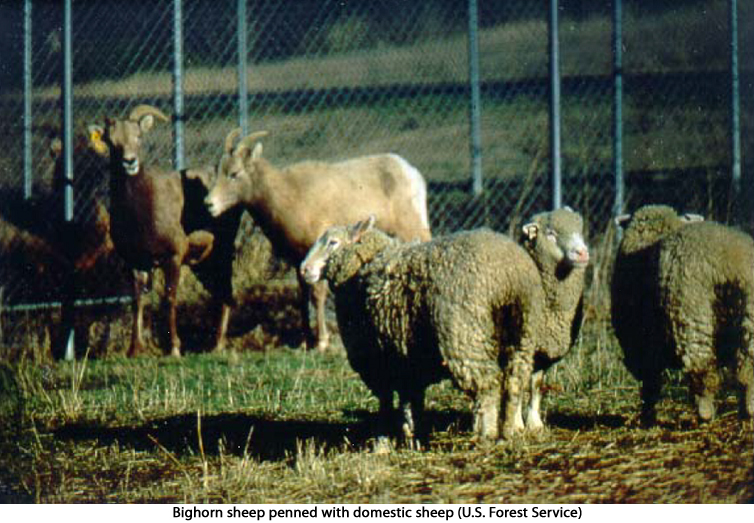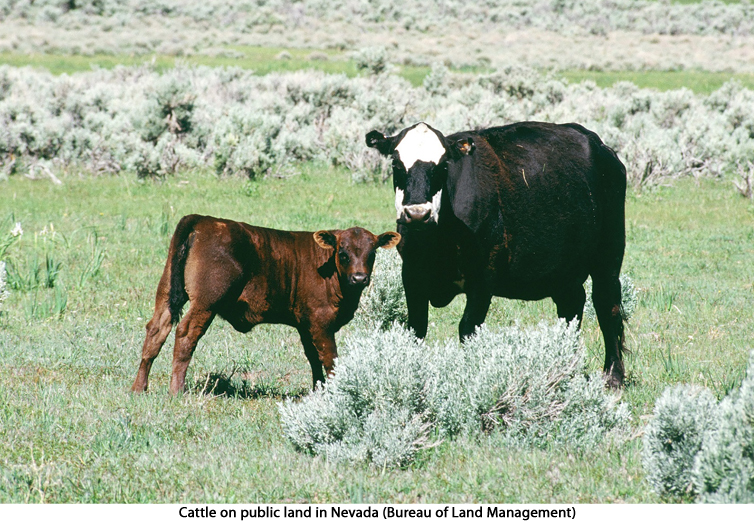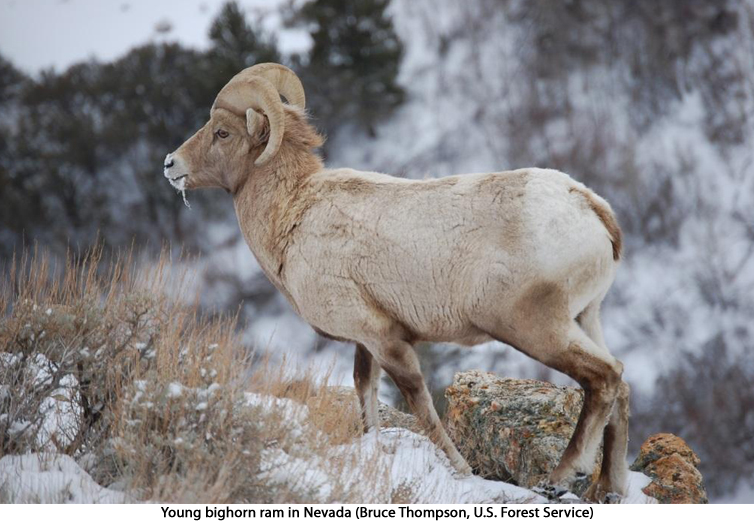EXCLUSIVITY OF DOMESTIC SHEEP AS FATAL DISEASE VECTOR
Other Species Tested
Domestic sheep are not the only ungulate species that can casually infect bighorns with fatal disease, but they stand out. In nine independent contact experiments (conducted in 1992, 1994, 1996, and 2009), bighorns were penned with: domestic goats (Capra hircus), cattle (Bos taurus), horses (Equus caballus), llamas (Lama glama), elk (Cervus elephus), white-tailed deer (Odocoileus virginianus), mule deer (Odocoileus hemionus), and mountain goats (Oreamnos americanus). In the studies, four of 55 bighorns died. Of these, one old bighorn ewe’s death was likely caused by poor dentition that hindered feeding capacities (Wehausen, Kelley, and Ramey II 2011). One bighorn died of pneumonia while penned with cattle, and “two of seven bighorn co-pastured in one trial with domestic goats . . . died of pneumonia caused by Mannheimia haemolytica . . .” (Wehausen, Kelley, and Ramey II 2011, 11).

Domestic Goat Threat
Domestic goats stand out as the primary livestock species other than sheep that can pose a serious disease risk to bighorns (Wehausen, Kelley, and Ramey II 2011). Regarding the results of a study where pneumonia bacteria were isolated from feral goats and free-ranging bighorns in the Hells Canyon area, Rudolph et al. state:
“It was concluded that identical Pasteurella strains were shared by the goats and bighorn sheep. Although the direction of transmission could not be established, evidence suggests transmission of strains from goats to bighorn sheep. Goats may serve as a reservoir of Pasteurella strains that may be virulent in bighorn sheep; therefore, goats in bighorn . . . habitat should be managed to prevent contact with bighorn sheep” (2003, 897).
Circumstantial evidence implicating goats as transmitters of disease to wild sheep comes from a 2003-2004 desert bighorn disease outbreak in Arizona’s Silver Bell Mountains (Jansen et al. 2007). Wakeling states that the bighorns “contracted keratoconjunctivitis and contagious echthyma after exposure to domestic goats that were released without permission during fall 2003” (2005, 50). One hundred or more goats gained access to bighorn habitat. Disease symptoms were observed in bighorns four weeks after goats were spotted in wild sheep range (Jansen et al. 2007).
Domestic goats may also have played a role in a winter 2009-2010 bighorn die-off that occurred in Nevada’s East Humboldt Range (McAdoo, Wolff, and Cox 2010). McAdoo, Wolff, and Cox state: “Approximately 2,000 meat goats grazed the southern end of the East Humboldt’s on high elevation private lands in 2006, straying was documented, and known contact with at least a single bighorn ram occurred in 2007 (ram euthanized and full necropsy performed)” (2010, 52).

Exotic Threat
Some exotic ungulates pose a disease risk to bighorns (Wehausen, Kelley, and Ramey II 2011). In an experiment (results published in 1994) in which six bighorns were co-pastured with five mouflon sheep (Ovis orientalis), all bighorns died (Valdez and Krausman 1999; Wehausen, Kelley, and Ramey II 2011). Mouflon sheep are of Asiatic origin. Free-ranging exotic aoudads (Ammotragus lervia) of North African origin also present a disease threat (Valdez and Krausman 1999; Richardson 2007). A 1981 estimate indicated 6,500 aoudads lived in the southwestern U.S. (Valdez and Krausman 1999). Aoudads occur in Texas bighorn habitat. Regarding aoudads, the Texas Parks and Wildlife Department (TPWD) emphasizes that: “Competition for forage, dominance over bighorn sheep at water locations, and disease risks are among serious concerns” (Richardson 2007, 74). From 2008-2011, the TPWD removed about 1,000 exotic Barbary sheep in some regions as part of desert bighorn management (WAFWA 2011).
Vague Cattle Threat
Hunter illustrates the above point by discussing bighorns’ relationship with cattle:
“I think cattle could potentially carry Pasteurella organisms that are deadly to bighorn sheep, but why haven’t we found it? Well, if you look on the hillside, I think you’ll find that bighorn sheep and domestic sheep will get together. You know they’re kind of curious; they do go nose-to-nose. But, I don’t think bighorn like cows. Those . . . who work on . . . allotments will see that bighorn sheep and cattle rarely, if ever, have been seen nose to nose. The potential is there, although they do not get together” (Miller et al. 1995, 102).
While bighorns may not interact with cattle often, they sometimes get close. For example, in the winter of 2007-2008, free-ranging bighorns in southern Colorado suffered a die-off after likely contracting pneumonia from cattle. Disease transmission may have occurred when the bighorns fed with cattle on a rancher’s feed lines during harsh winter weather (Wolfe et al. 2010).
According to the Wild Sheep Working Group (WSWG) of the Western Association of Fish and Wildlife Agencies (WAFWA):
“The landowner/cattle producer was cooperative, and testing indicated that pathogen transfer between bighorn and cattle likely occurred. Based on this and other anecdotal reports, Colorado had sent recommended edits to the WAFWA guidelines that recognize some risk, although much lower, from domestic ruminants other than sheep and goats. Representatives of the other states and provinces were not supportive of including references to cattle in the WAFWA guidelines” (2010a, 2).

Furthermore, according to the minutes of a February 2010 WSWG meeting, regarding a bighorn die-off in Nevada’s East Humboldt Mountains: “Cattle near the [East] Humboldts tested positive for pneumonia, but it is unknown if there is any connection” (WAFWA 2010b, 3). McAdoo, Wolff, and Cox state: “Approximately 19 cattle died in the East Humboldt’s in early summer 2009 from pneumonia (confirmed in 1 animal) in proximity to a water tank in the core of the die-off area where [bighorn] rams were observed using this water tank with dead cattle around it” (2010, 52).
Behavioral Factors and Relatedness
The hypothesis that stress plays a major role in bighorn pneumonia epizootics is weakened by the fact that bighorns often die from contact with sheep of Old World origin but not from contact with several other species (Wehausen, Kelley, and Ramey II 2011). Wehausen, Kelley, and Ramey II mention that there is also “a lack of circumstantial data linking most of these other species to bighorn sheep die-offs” (2011, 11). Nonetheless, Wehausen, Kelley, and Ramey II point out that “the lack of disease transmission to bighorn sheep by the other species tested does not imply that they lack respiratory tract organisms pathogenic to bighorn sheep; instead, lack of disease may result from interspecific behavioral patterns that largely preclude contact and pathogen transmission” (2011, 11).
The behavior and relatedness of wild and domestic sheep help explain why domestic sheep are the type of animal most often associated with bighorn epizootics. Bighorns and domestic sheep are closely related and capable of interbreeding. Thus, bighorns are more likely to interact with domestic sheep than other livestock (Cahn et al. 2011; Miller et al. 1995).
Wandering Sheep
Bighorn movement patterns are another factor making domestic sheep especially likely disease vectors (DBC Technical Staff 1990). During the breeding season, young bighorn rams tend to move great distances in search of ewes (Valdez and Krausman 1999). The Desert Bighorn Council's technical staff mentions a distance of less than or equal to 64 km (40 mi) for desert bighorn ram travel (1990). Based on data from 61 Sierra bighorns, maximum movement distances for rams ranged from 11-59 km (7-37 mi). Ewe distances ranged from 7-23 km (4-14 mi). Bighorn ewes generally do not travel as far as rams (USFWS 2007).

Extensive movements by rams may bring bighorns in contact with domestic sheep. After contracting disease, infected rams could then return to their herds and cause an epizootic (USFWS 2007). Bighorn rams may interact with domestic sheep during the breeding season because they’re attracted to domestic ewes (Aune et al. 1998). For example, “in Montana, at least 4 cases of young rams breeding with domestic sheep have been reported since 1990” (Aune et al. 1998, 62). In addition to mate-seeking, other possible movement-influencing factors include: “social status, age, nutritional status, herd size, population density, predation risk, and habitat availability” (USFWS 2007, 111).
In addition to lone bighorn rams making distant jaunts, domestic sheep may also turn up in unexpected places and not stick to their grazing allotments. For example, Cummings and Stevenson state that: “Desert bighorn populations on the East Range and Tobin Range [of Nevada] initiated declines in August 1991; the declines coincided with detection of trespass domestic sheep in bighorn habitat. In July 1994, it was concluded the Tobin population no longer existed and that the East Range population was nearly extirpated” (1995, 79). Shannon et al. elaborate on a case of trespassing domestic sheep in Utah:
“Domestic sheep continue to threaten the persistence of bighorns on Mount Nebo. In 2007, there were 6 sightings of domestic sheep with bighorns, or in bighorn habitat. No domestic sheep allotments currently exist on Mount Nebo; yet, domestic sheep still frequent this area, raising serious management concerns. Usually, dispersing bighorn rams are the vector for transmitting diseases to bighorn herds, but in this population, domestic sheep have trespassed into bighorn habitat. It seems unlikely that this herd will succeed unless domestic sheep are eradicated from the area and prevented from returning” (2008, 182).
According to the minutes of a February 2010 meeting of the WSWG, regarding stray domestic sheep on the Payette National Forest:
“There are occasions where [domestic sheep] move outside of their allotment boundaries, and there are instances when a stray [domestic sheep] is there overwinter. There is very poor data on this. . . . The USFS policy regarding an errant [domestic sheep] is to try to get it back with its owner; if that does not work, then the sheriff gives [the Idaho Department of Fish and Game] permission to remove stray [domestic sheep]” (WAFWA 2010b, 5).
The minutes of a January 2012 meeting of the WSWG detail a more recent example of unexpected domestic sheep straying in Nevada:
“There have been 2 dieoffs: a CA herd that lost ½ the population; and a recent desert dieoff whose extent is still unknown. Domestic sheep were present and they received permission to shoot them out of a helicopter. Samples were taken from both the domestics and wild sheep and comingling was confirmed in one of the dieoffs. In both events, domestics moved over 40 miles, and in one case a ewe/lamb pair went 50 miles” (WAFWA 2012, 6).
REFERENCES
Aune, Keith, Neil Anderson, David Worley, Larry Stackhouse, James Henderson, and Jen’E Daniel. 1998. A comparison of population and health histories among seven Montana bighorn sheep populations. In proceedings of Northern Wild Sheep and Goat Council’s 11th Biennial Symposium, Whitefish, MT. April 16-20.
Cahn, Maya L., Mary M. Conner, Oswald J. Schmitz, Thomas R. Stephenson, John D. Wehausen, and Heather E. Johnson. 2011.Disease, population viability, and recovery of endangered Sierra Nevada bighorn sheep. Journal of Wildlife Management 75, no. 8 (November): 1753-1766.
Cummings, Patrick J., and Craig Stevenson. 1995. Status of desert bighorn sheep in Nevada – 1994. In transactions of Desert Bighorn Council’s 39th Annual Meeting, Alpine, TX. April 5-7.
Desert Bighorn Council (DBC) Technical Staff. 1990. Guidelines for the management of domestic sheep in the vicinity of desert bighorn habitat. In transactions of DBC’s 34th Annual Meeting, Hermosillo, Sonora, Mexico. April 4-6.
Jansen, Brian D., Paul R. Krausman, James R. Heffelfinger, Ted H. Noon, and James C. Devos, Jr. 2007. Population dynamics and behavior of bighorn sheep with infectious keratoconjunctivitus. The Journal of Wildlife Management 71, no. 2 (April): 571-575.
McAdoo, Caleb, Peregrine Wolff, and Mike Cox. 2010. Investigation of Nevada’s 2009-2010 East Humboldt Range and Ruby Mountain bighorn dieoff. In proceedings of Northern Wild Sheep and Goat Council’s 17th Biennial Symposium, Hood River, OR. June 7-11.
Miller, Mike (moderator), Walter Boyce, Marie Bulgin, Bill Foreyt, David Hunter, and Terry Spraker (panel members). 1995. Livestock/bighorn sheep disease transmission. Discussion in transactions of Desert Bighorn Council’s 39th Annual Meeting, Alpine, TX. April 5-7.
Richardson, Calvin L. 2007. Status of desert bighorn sheep in Texas, 2006-2007. In transactions of Desert Bighorn Council’s 49th Annual Meeting, Las Vegas, NV. April 3-6.
Rudolph, Karen M., David L. Hunter, William J. Foreyt, E. Frances Cassirer, Richard B. Rimler, and Alton C.S. Ward. 2003. Sharing of Pasteurella spp. between free-ranging bighorn sheep and feral goats. Journal of Wildlife Diseases 39, no. 4 (October): 897-903.
Shannon, Justin M., Daniel D. Olson, Jericho C. Whiting, Jerran T. Flinders, and Tom S. Smith. 2008. Status, distribution, and history of Rocky Mountain bighorn sheep in Utah. In proceedings of Northern Wild Sheep and Goat Council’s 16th Biennial Symposium, Midway, UT. April 27-May 1.
U.S. Fish and Wildlife Service (USFWS). 2007. Recovery Plan for the Sierra Nevada Bighorn Sheep. Sacramento. http://www.nps.gov/yose/naturescience/loader.cfm?csModule= security/getfile&PageID=382279 (accessed October 15, 2011). [govt. doc.]
Valdez, Raul, and Paul R. Krausman, eds. 1999. Mountain sheep of North America. Tucson: The University of Arizona Press.
Wehausen, John D., Scott T. Kelley, and Rob R. Ramey II. 2011. Domestic sheep, bighorn sheep, and respiratory disease: A review of the experimental evidence. California Fish and Game 97, no. 1 (Winter): 7-24.
Western Association of Fish and Wildlife Agencies (WAFWA). 2010a. WAFWA Wild Sheep Working Group Meeting: Hood River Inn, Oregon [in conjunction with 2010 NWSGC Symposium] – June 8, 2010 (7:30-9:30 pm). N.p.: WAFWA. http://www.wafwa.org/ documents/wswg/wswgminutes06082010.pdf (accessed May 26, 2012).
Western Association of Fish and Wildlife Agencies (WAFWA). 2010b. Western Association of Fish and Wildlife Agencies (WAFWA) Wild Sheep Working Group (WSWG) Winter Meeting: February 2-3, 2010, Reno, Nevada. N.p.: WAFWA. http://www.wafwa.org/ documents/wswg/wswgminutes02032010.pdf (accessed May 26, 2012).
Western Association of Fish and Wildlife Agencies (WAFWA). 2011.WAFWA Wild Sheep Working Group Winter Meeting (1:00 – 5:00 PM: February 8, 2011; 8:00 AM – Noon: February 9, 2011, Reno-Sparks Convention Center, Room #A6). N.p.: WAFWA. http://www. wafwa.org/documents/wswg/wswgminutes0208-0911.pdf (accessed July 11, 2012).
Western Association of Fish and Wildlife Agencies (WAFWA). 2012. WAFWA Wild Sheep Working Group Meeting, January 17-18, 2012 – WSF Convention-Reno, NV – Reno-Sparks Convention Center – Room A6. N.p. WAFWA. http://www.wafwa.org/documents/wswg/ws wgminutes011712.pdf (accessed May 27, 2012).
Wolfe, Lisa L., Brandon Diamond, Terry R. Spraker, Michael A. Sirochman, Daniel P. Walsh, Chandra M. Machin, Donald J. Bade, and Michael W. Miller. 2010. A bighorn sheep die-off in southern Colorado involving a Pasteurellaceae strain that may have originated from synoptic cattle. Journal of Wildlife Diseases 46, no. 4 (October): 1262-1268.
